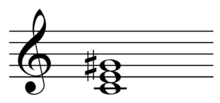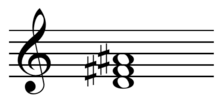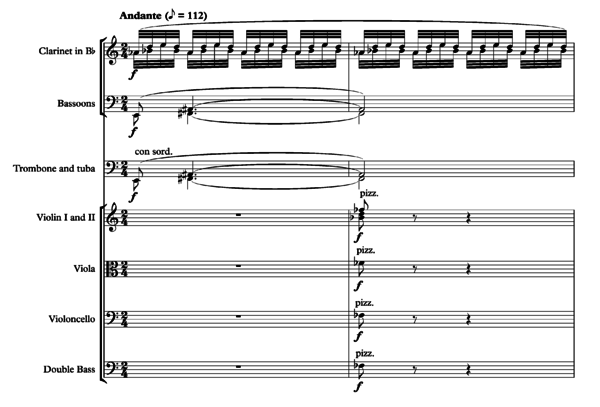Whole tone scale
| Qualities | |
|---|---|
| Number of pitch classes | 6 |
| Forte number | 6-35 |
| Complement | 6-35 |
In music, a whole tone scale is a scale in which each note is separated from its neighbours by the interval of a whole tone. There are only two complementary whole tone scales, both six-note or hexatonic scales:
The whole tone scale has no leading tone and because all tones are the same distance apart, "no single tone stands out, [and] the scale creates a blurred, indistinct effect".[1] This effect is especially emphasised by the fact that triads built on such scale tones are augmented. Indeed, one can play all six tones of a whole tone scale simply with two augmented triads whose roots are a major second apart. Since they are symmetrical, whole tone scales do not give a strong impression of the tonic or tonality.


The composer Olivier Messiaen called the whole tone scale his first mode of limited transposition. The composer and music theorist George Perle calls the whole tone scale interval cycle 2, or C2. Since there are only two possible whole tone scale positions (that is, the whole tone scale can be transposed only once), it is either C20 or C21. For this reason, the whole tone scale is also maximally even and may be considered a generated collection.
Due to this symmetry, the hexachord consisting of the whole-tone scale is not distinct under inversion or more than one transposition. Thus many composers have used one of the "almost whole-tone" hexachords, whose "individual structural differences can be seen to result only from a difference in the 'location,' or placement, of a semitone within the otherwise whole-tone series."[2] Alexander Scriabin's mystic chord is a primary example, being a whole tone scale with one note raised a semitone, with this alteration allowing for a greater variety of resources through transposition.[3]
Classical music
Use of the melodic whole tone scale can be traced at least as far back as Johann Sebastian Bach. The concluding chorale movement of his cantata O Ewigkeit du Donnerwort BWV60, opens with four notes from the whole tone scale:

Mozart also used the scale in his Musical Joke, for strings and horns. In the 19th century Russian composers went further with melodic and harmonic possibilities of the scale, often to depict the ominous; consider the endings of the overtures to Glinka's opera Ruslan and Lyudmila and Borodin's Prince Igor, and the Commander's theme in Dargomyzhsky's The Stone Guest. Further examples can be found in the works of Rimsky-Korsakov: the sea king's music in Sadko and also in Scheherezade:

(For some short piano pieces written completely in whole-tone scale, see nos. 1, 6, and 7 from V.A. Rebikov's Празднество (Une fête), Op. 38, from 1907.)
H. C. Colles names as the "childhood of the whole-tone scale" the music of Berlioz and Schubert in France and then Russians Glinka and Dargomyzhsky.[5] Claude Debussy, who had been influenced by Russians, along with other Impressionist composers made extensive use of whole tone scales:
Debussy asks the pianist to play Voiles "dans un rythme sans rigueur at caressant." The sense of mystery and ambiguity here even extends to the title of the piece, which translates either as ‘Sails’ or ‘Veils.’ Janáček’s use of the scale in the bracing opening to the second movement of his Sinfoniettais, to quote Austin (1966, p.81) "utterly different":

"Janáček’s free chromaticism never loses touch with a diatonic scale for long. Though the whole-tone scale is prominent in much of his music after 1905 when he encountered Debussy, it serves simply to fit the motifs over augmented chords. The same motifs return from the whole-tone to the diatonic scale without emphasizing the contrast."[8]
The first of Alban Berg's Seven Early Songs opens with a whole-tone passage both in the orchestral accompaniment and in the vocal line that enters a bar later.[9] Berg also quotes the Bach chorale setting referred to above in his Violin Concerto. The last four notes of the 12-tone row Berg used are B, C♯, E♭ and F, which, together with the first note, G, comprise 5 of the 6 notes of the scale.) Béla Bartók also uses whole-tone scales in his Fifth String Quartet. Ferruccio Busoni used the whole tone scale in the right hand part of the "Preludietto, Fughetta ed Esercizio" of his An die Jugend, and Franz Liszt applied the whole tone scale to parts of the score of his Dante Symphony (1857), but he had used the technique as early as 1831, in the Grande Fantaisie sue La clochette.[10]
Jazz harmony
An early instance of the use of the scale in jazz writing can be found in Don Redman’s “Chant of the Weed” (1931). In 1958, Gil Evans recorded an arrangement that gives striking coloration to passages featuring whole-tone harmonies. Wayne Shorter's composition "Juju" (1965),[11] features heavy use of the whole tone scale, and John Coltrane's "One Down, One Up" (1965), is built on two augmented chords arranged in the same simple structure as his earlier tune "Impressions".[12] However, these are only the most overt examples of the use of this scale in jazz. A vast number of jazz tunes, including many standards, use augmented chords and their corresponding scales as well, usually to create tension in turnarounds or as a substitute for a dominant seventh chord. For instance a G7 augmented 5th dominant chord in which G altered scale tones would work before resolving to C7, a tritone substitution chord such as D♭9 or D♭7 augmented 11th is often used in which D♭/G whole tone scale tones will work, the sharpened 11th degree being a G and the flattened 7th being a C♭, the enharmonic equivalent of B, the major third in the G dominant chord. Art Tatum and Thelonious Monk are two pianists who used the whole tone scale extensively and creatively. Thelonious Monk's "Four in One" (1948) [13] and "Trinkle-Tinkle" (1952) [14] are fine examples of this.
A prominent example of the whole tone scale that made its way into pop music are bars 3 and 4 of the opening of Stevie Wonder's 1972 song "You are the Sunshine of my Life".[15]
Non-western music
The rāga Sahera in Hindustani classical music uses the same intervals as the whole tone scale. Ustad Mehdi Hassan has performed this rāga.[16] Gopriya is the corresponding Carnatic rāgam.
See also
Sources
- ↑ Kamien, Roger (2008). Music: An Appreciation, Sixth Brief Edition, p.308. ISBN 978-0-07-340134-8.
- ↑ Schmalfeldt, Janet (1983). Berg's Wozzeck: Harmonic Language and Dramatic Design, p.48. ISBN 0-300-02710-9.
- ↑ "The Evolution of Twelve-Note Music", p.56. Oliver Neighbor. Proceedings of the Royal Musical Association, 81st Sess. (1954 - 1955), pp. 49-61.
- ↑ Abraham, Gerald. "The Whole-Tone Scale in Russian Music", p.602, The Musical Times, Vol. 74, No. 1085. (Jul., 1933), pp. 602-604.
- ↑ "The Childhood of the Whole-Tone Scale", p.17-19. H. C. Colles. The Musical Times, Vol. 55, No. 851. (Jan. 1, 1914), pp. 16-20. The Musical Times is currently published by Musical Times Publications Ltd.
- ↑ Benward & Saker (2009). Music in Theory and Practice: Volume II, p.246. Eighth Edition. ISBN 978-0-07-310188-0.
- ↑ Benward & Saker (2003). Music: In Theory and Practice, Vol. I, p.39. Seventh Edition. ISBN 978-0-07-294262-0.
- ↑ Austin, W. (1966) Music in the Twentieth Century. London, Dent.
- ↑ Berg (1928), Sieben Fruhe Lieder, Wien, Universal Edition
- ↑ Jeremy Nicholas, "Loving Liszt", Limelight, April 2011, p. 50
- ↑ Wayne Shorter Jazz Play Along, Milwaukee,Hal Leonard
- ↑ Impressions (sheet music, 1991) from The Music of John Coltrane, Milwaukee, Hal Leonard
- ↑ Four in One from Cardenas, S. and Sickler, D. (eds.) Thelonious Monk Fakebook, Milwaukee, Hal Leonard.
- ↑ "Trinkle-Tinkle" from Cardenas, S. and Sickler, D. (eds.) Thelonious Monk Fakebook, Milwaukee, Hal Leonard.
- ↑ Everett, Walter (2008). The Foundations of Rock : From "Blue Suede Shoes" to "Suite: Judy Blue Eyes". Oxford University Press. p. 174. ISBN 9780199718702.
- ↑ https://www.youtube.com/watch?v=GHP-mSmr9hY

